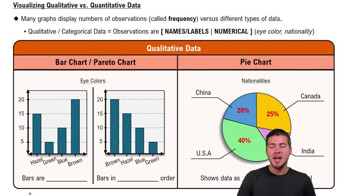Variance of Roller Coaster Speeds The standard deviation of the sample values in Exercise 1 is 43.1 km/h. What is the variance (including units)?
Table of contents
- 1. Intro to Stats and Collecting Data1h 14m
- 2. Describing Data with Tables and Graphs1h 55m
- 3. Describing Data Numerically2h 5m
- 4. Probability2h 16m
- 5. Binomial Distribution & Discrete Random Variables3h 6m
- 6. Normal Distribution and Continuous Random Variables2h 11m
- 7. Sampling Distributions & Confidence Intervals: Mean3h 23m
- Sampling Distribution of the Sample Mean and Central Limit Theorem19m
- Distribution of Sample Mean - Excel23m
- Introduction to Confidence Intervals15m
- Confidence Intervals for Population Mean1h 18m
- Determining the Minimum Sample Size Required12m
- Finding Probabilities and T Critical Values - Excel28m
- Confidence Intervals for Population Means - Excel25m
- 8. Sampling Distributions & Confidence Intervals: Proportion1h 25m
- 9. Hypothesis Testing for One Sample3h 29m
- 10. Hypothesis Testing for Two Samples4h 50m
- Two Proportions1h 13m
- Two Proportions Hypothesis Test - Excel28m
- Two Means - Unknown, Unequal Variance1h 3m
- Two Means - Unknown Variances Hypothesis Test - Excel12m
- Two Means - Unknown, Equal Variance15m
- Two Means - Unknown, Equal Variances Hypothesis Test - Excel9m
- Two Means - Known Variance12m
- Two Means - Sigma Known Hypothesis Test - Excel21m
- Two Means - Matched Pairs (Dependent Samples)42m
- Matched Pairs Hypothesis Test - Excel12m
- 11. Correlation1h 6m
- 12. Regression1h 50m
- 13. Chi-Square Tests & Goodness of Fit1h 57m
- 14. ANOVA1h 57m
3. Describing Data Numerically
Standard Deviation
Problem 3.2.29
Textbook Question
Estimating Standard Deviation with the Range Rule of Thumb. In Exercises 29–32, refer to the data in the indicated exercise. After finding the range of the data, use the range rule of thumb to estimate the value of the standard deviation. Compare the result to the standard deviation computed using all of the data.
Body Temperatures Refer to Data Set 5 “Body Temperatures” in Appendix B and use the body temperatures for 12:00 AM on day 2.
 Verified step by step guidance
Verified step by step guidance1
Step 1: Identify the range of the data. The range is calculated as the difference between the maximum and minimum values in the dataset. Use the formula: .
Step 2: Apply the range rule of thumb to estimate the standard deviation. The rule states that the standard deviation can be approximated as one-fourth of the range. Use the formula: .
Step 3: Compare the estimated standard deviation to the actual standard deviation. To do this, compute the actual standard deviation using all the data points. The formula for the standard deviation is: , where represents each data point, is the mean, and is the number of data points.
Step 4: Analyze the difference between the estimated standard deviation (using the range rule of thumb) and the actual standard deviation (calculated using the formula). This comparison helps assess the accuracy of the range rule of thumb.
Step 5: Conclude whether the range rule of thumb provides a reasonable estimate for the standard deviation in this specific dataset. Discuss any potential limitations or factors that might affect the accuracy of the estimate.
 Verified video answer for a similar problem:
Verified video answer for a similar problem:This video solution was recommended by our tutors as helpful for the problem above
Video duration:
7mPlay a video:
Was this helpful?
Key Concepts
Here are the essential concepts you must grasp in order to answer the question correctly.
Range Rule of Thumb
The Range Rule of Thumb is a simple method for estimating the standard deviation of a dataset. It states that the standard deviation can be approximated by dividing the range of the data (the difference between the maximum and minimum values) by four. This rule provides a quick way to gauge variability without performing complex calculations, making it useful for initial assessments.
Recommended video:

Probability of Mutually Exclusive Events
Standard Deviation
Standard deviation is a statistical measure that quantifies the amount of variation or dispersion in a set of values. A low standard deviation indicates that the values tend to be close to the mean, while a high standard deviation indicates that the values are spread out over a wider range. It is a crucial concept in statistics as it helps to understand the distribution of data points.
Recommended video:
Guided course

Calculating Standard Deviation
Data Set Comparison
Comparing estimates derived from the Range Rule of Thumb with the actual standard deviation calculated from the entire dataset allows for an assessment of the accuracy of the estimation method. This comparison can highlight the effectiveness of the Range Rule of Thumb in providing a quick approximation and can also reveal any significant discrepancies that may arise due to the nature of the data.
Recommended video:
Guided course

Visualizing Qualitative vs. Quantitative Data

 8:45m
8:45mWatch next
Master Calculating Standard Deviation with a bite sized video explanation from Patrick
Start learningRelated Videos
Related Practice
Textbook Question
